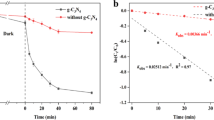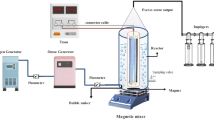Abstract
The method of preparing Zn0.75Mn0.75Fe1.5O4/ZnFe2O4/ZnO photocatalyst was the precipitation grinding. This photocatalyst was characterized by UV-Vis, PL, EDS, SEM, and XRD. The results indicated the Zn0.75Mn0.75Fe1.5O4/ZnFe2O4/ZnO photocatalyst was highly active under the visible light. The photocatalytic degradation efficiency of chlortetracycline hydrochloride was analyzed in mariculture wastewater by various experimental parameters, namely calcination temperature, dosage of Zn0.75Mn0.75Fe1.5O4/ZnFe2O4/ZnO, Zn2+/Fe3+/Mn2+ molar ratio, H2O2 mass concentration, chlortetracycline hydrochloride initial concentration, and illumination time. The degradation of chlortetracycline hydrochloride in mariculture wastewater was optimized by orthogonal experiments. When the H2O2 mass concentration was 0.3 g/L, calcination temperature was 500 °C, Zn2+/Fe3+/Mn2+ molar ratio was 10:1:4, dosage of Zn0.75Mn0.75Fe1.5O4/ZnFe2O4/ZnO was 0.7 g/L, illumination time was 4.0 h, chlortetracycline hydrochloride initial concentration was 0.01 g/L, and the degradation rate of chlortetracycline hydrochloride reached 73.04% by Zn0.75Mn0.75Fe1.5O4/ZnFe2O4/ZnO photocatalyst. The degradation rate of chlortetracycline hydrochloride was 52.86% by ZnFe2O4/ZnO photocatalyst. The results indicated that the Zn0.75Mn0.75Fe1.5O4/ZnFe2O4/ZnO photocatalyst obviously enhanced the degradation rate of chlortetracycline hydrochloride, compared with pure ZnO and ZnFe2O4/ZnO photocatalyst.







Similar content being viewed by others
References
AbuMousa, R. A., Baig, U., Gondal, M. A., Dastageer, M. A., AlSalhi, M. S., Moftah, B., & Sfouq Aleanizy, F. (2020). Investigation of the survival viability of cervical cancer cells (HeLa) under visible light induced photo-catalysis with facile synthesized WO3/ZnO nanocomposite. Saudi Journal of Biological Sciences, 1743–1752.
Chakrabarti, S., Dutta, B. K., & Hazard Mater, J. (2004). Photocatalytic degradation of model textile dyes in wastewater using ZnO as semiconductor catalyst. Journal of Hazardous Materials, 112, 269–278.
Chong, M. N., Jin, B., Chow, C. W. K., & Saint, C. (2010). Recent developments in photocatalytic water treatment technology: a review. Water Research, 44(10), 2997–3027.
Cun, W., Jin, C., Zhao, X., Wang, B., & Mai, G. (2002). Preparation, characterization and photocatalytic activity of nano-sized ZnO/SnO2 coupled photocatalysts. Applied Catalysis B: Environmental, 39(3).
da Silva, A. C., Almeida, M. R., Rodriguez, M., Machado, A. R. T., de Oliveira, L. C. A., & Pereira, M. C. (2017). Improved photocatalytic activity of δ-FeOOH by using H2O2 as an electron acceptor. Journal of Photochemistry and Photobiology, A: Chemistry, 332, 54–59.
Dai, Y., Liu, Y., Kong, J., Yuan, J., Sun, C., & Xian, Q. (2019). High photocatalytic degradation efficiency of oxytetracycline hydrochloride over Ag/AgCl/BiVO4 plasmonic photocatalyst. Solid State Sciences, 96.
Fu, P., Luan, Y., & Dai, X. (2004). Preparation of activated carbon fibers supported TiO2 photocatalyst and evaluation of its photocatalytic reactivity. Journal of Molecular Catalysis A: Chemical, 221, 1–2.
Gao, Y., Li, Y., Zhang, L., Huang, H., Hu, J., Shah, S. M., & Su, X. (2012). Adsorption and removal of tetracycline antibiotics from aqueous solution by graphene oxide. Journal of Colloid and Interface Science, 368(1), 540–546.
Hirose, J., Kondo, F., Nakano, T., Kobayashi, T., Hiro, N., Ando, Y., et al. (2005). Inactivation of antineoplastics in clinical wastewater by electrolysis. Chemosphere, 60(8), 1018–1024.
Jara, C. C., Fino, D., Specchia, V., Saracco, G., & Spinelli, P. (2007). Electrochemical removal of antibiotics from wastewaters. Applied Catalysis B: Environmental, 70(1), 479–487.
Ku, Y., Leu, R. M., Lee, K. C., & Res, W. (1996). Decomposition of 2-chlorophenol in aqueous solution by UV irradiation with the presence of titanium dioxide. Water Research, 30, 2569–2578.
Mishra, M., & Chun, D.-M. (2015). α-Fe2O3 as a photocatalytic material: a review. Applied Catalysis A: General, 498, 126–141.
Miyazaki, S., Arita, T., Hori, R., & Ito, K. (1974). Effect of polymorphism on the dissolution behavior and gastrointestinal absorption of chlortetracycline hydrochloride. Chemical & Pharmaceutical Bulletin, 22(3), 638–642.
Moon, J., Takagi, H., Fujishiro, Y., & Awano, M. (2001). Preparation and characterization of the Sb-doped TiO2 photocatalysts. Journal of Materials Science, 36(4), 949–955.
Putra, E. K., Pranowo, R., Sunarso, J., Indraswati, N., & Ismadji, S. (2009). Performance of activated carbon and bentonite for adsorption of amoxicillin from wastewater: mechanisms, isotherms and kinetics. Water Research, 43(9), 2419–2430.
Samadi, M., Zirak, M., Naseri, A., Khorashadizade, E., & Moshfegh, A. Z. (2016). Recent progress on doped ZnO nanostructures for visible-light photocatalysis. Thin Solid Films, 605, 2–19.
Shemeena, M., & Binitha, N. N. (2020). Visible light active ZnO–g-C3N4 photocatalyst for dye pollutant degradation. Proceedings: Materials Today.
Silva, D., & Sena, S. (2000). A global perspective of aquaculture in the new millennium. Technical Proceedings of the Conference on Aquaculture in the Third Millennium, 431–459.
Tang, X., Ni, L., Han, J., & Wang, Y. (2017). Preparation and characterization of ternary magnetic g-C 3 N 4 composite photocatalysts for removal of tetracycline under visible light. Chinese Journal of Catalysis, 38(3), 447–457.
Tian, G., Fu, H., Jing, L., & Tian, C. (2009). Synthesis and photocatalytic activity of stable nanocrystalline TiO2 with high crystallinity and large surface area. Journal of Hazardous Materials, 161, 2–3.
Vesseur, E. J. R., Coenen, T., Caglayan, H., & Engheta, P. (2013). Experimental verification of n=0 structures for visible light. Physical Review Letters, 110(1).
Vieno, N. M., Härkki, H., Tuhkanen, T., & Kronberg, L. (2007). Occurrence of pharmaceuticals in river water and their elimination in a pilot-scale drinking water treatment plant. Environmental Science & Technology, 41(14), 5077–5084.
Xiang-ying, Z. (2008). Bioanalysis and the application on treatment of wastewater. In Shandong Food Ferment.
Yu, C., & Yu, J. C. (2009). A simple way to prepare C–N-codoped TiO2 photocatalyst with visible-light activity. Catalysis Letters, 129, 3–4.
Yu, C., Jimmy, C., Zhou, W., & Yang, K. (2010). WO3 coupled P-TiO2 photocatalysts with mesoporous structure. Catalysis Letters, 140, 3–4.
Yu, C., Yang, Q., Shu, Q., Jimmy, C., & Cao, F. (2011). Preparation of WO3/ZnO composite photocatalyst and its photocatalytic performance. Chinese Journal of Catalysis, 32, 3–4.
Funding
We received financial support from the State Oceanic Administration People’s Republic of China (201305002), Liaoning Science and Technology Public Welfare Fund (20170002), Science Foundation of Department of Ocean and Fisheries of Liaoning Province (201733), and Department of Science and Technology of Liaoning (2016LD0105) for this study.
Author information
Authors and Affiliations
Corresponding author
Additional information
Publisher’s Note
Springer Nature remains neutral with regard to jurisdictional claims in published maps and institutional affiliations.
Rights and permissions
About this article
Cite this article
Fu, J., Yu, X., Li, Z. et al. Study on the Degradation of Chlortetracycline Hydrochloride in Mariculture Wastewater by Zn0.75Mn0.75Fe1.5O4/ZnFe2O4/ZnO Photocatalyst. Water Air Soil Pollut 232, 12 (2021). https://doi.org/10.1007/s11270-020-04980-6
Received:
Accepted:
Published:
DOI: https://doi.org/10.1007/s11270-020-04980-6




